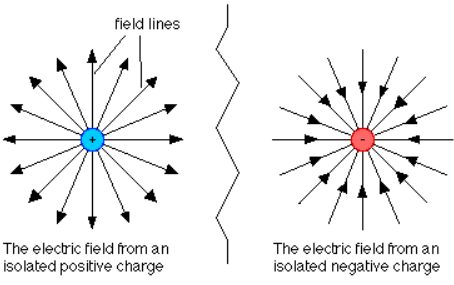Class 10 Exam > Class 10 Notes > Physics for GCSE/IGCSE > Electric Fields
Electric Fields | Physics for GCSE/IGCSE - Class 10 PDF Download
Electric Fields
- A charged object induces an electric field, akin to how magnets create magnetic fields.
- Electric fields resemble the magnetic fields generated by magnets.
- The presence of an electric field is demonstrated through electric field lines. These lines exhibit a consistent behavior of pointing outward from positive charges and inward toward negative charges.

- The direction of the field lines in an electric field indicates the direction of the force on a positive charge at that point.

- The intensity of an electric field is contingent upon the proximity to the charged source:
- The field exhibits its maximum strength in the immediate vicinity of the charged object, as evidenced by the convergence of field lines.
- Conversely, as one moves farther away from the charged object, the field weakens, illustrated by the divergence of field lines.
- Proximity to the charged object significantly influences the electric field:
- At close range, the field is at its most potent state, with field lines closely packed together.
- Conversely, at a distance from the object, the field strength diminishes, resulting in the field lines spreading further apart.
- Factors influencing electric field strength:
- At its strongest, the field is in immediate proximity to the charged object.
- In contrast, the field weakens as distance from the object increases, leading to a visible separation of field lines.
Electric Field Patterns
When objects are placed in an electric field, they will experience an electrostatic force. This force is a vector, meaning its direction depends on the charges involved.
- The direction of the electrostatic force depends on whether the charges are the same or opposite.
- If the charges are the same (both negative or both positive), the force is repulsive, causing the objects to move away from each other.
- If the charges are opposite (one negative and one positive), the force is attractive, causing the objects to move towards each other.

- The size of the force depends on the strength of the field at that point
- This means that the force becomes:
- Stronger as the distance between the two charged objects decreases
- Weaker as the distance between the two charged objects increases
- The correlation between force strength and distance pertains to both attraction and repulsion forces.
- When two negative charges are brought into proximity, their repulsive force increases compared to when they are distant from each other.
Field Lines Around a Point Charge
- The electric field represents the area where a charge would encounter a force.
- Field lines emanate from positive charges and converge towards negative charges, aligning with the direction of force acting on a positively charged particle within that field.

Question for Electric FieldsTry yourself: What is the relationship between the direction of electric field lines and the force on a positive charge?View Solution
Field Lines Between Two Oppositely Charged Parallel Conducting Plates
- Definition: Electric fields always point away from positive charges and toward negative charges.
- Characteristics of the Electric Field between Two Parallel Plates:
- The electric field is uniform.
- The field lines are directed from the positive to the negative plate in parallel straight lines.

The Field Lines around a Charge Conducting Sphere
- The field lines around a charge conducting sphere are symmetrical, similar to a point charge.
- The charges on the sphere's surface are evenly distributed.
- These charges, being alike, repel each other due to their same nature.
- Since the surface is conducting, the charges have the freedom to move.

- Field line patterns can be demonstrated using a Van de Graaff Generator.
- One method involves using streamers to visualize the electric field lines.
- Other common methods in schools include using small pieces of paper, polystyrene beads, and aluminum foil containers to demonstrate electric field patterns.
- Small pieces of paper
- Polystyrene beads
- Aluminum foil containers
The document Electric Fields | Physics for GCSE/IGCSE - Class 10 is a part of the Class 10 Course Physics for GCSE/IGCSE.
All you need of Class 10 at this link: Class 10
|
126 videos|182 docs|35 tests
|
FAQs on Electric Fields - Physics for GCSE/IGCSE - Class 10
| 1. What is an electric field? |  |
Ans. An electric field is a region around a charged object where another charged object will experience a force. It is a vector quantity that has both magnitude and direction.
| 2. How is the strength of an electric field measured? |  |
Ans. The strength of an electric field is measured in units of volts per meter (V/m). It represents the force per unit charge experienced by a test charge placed in the field.
| 3. How does the direction of an electric field relate to the direction of the force on a positive test charge? |  |
Ans. The direction of an electric field points in the direction that a positive test charge would move if placed in the field. The force on a positive test charge is in the same direction as the electric field.
| 4. How do electric fields interact with conductors and insulators? |  |
Ans. Electric fields can pass through insulators, affecting the arrangement of charges within the material. In conductors, electric fields cause charges to redistribute on the surface, leading to induced charges and potentially affecting the overall field.
| 5. How can the concept of electric fields be applied in real-world scenarios? |  |
Ans. Understanding electric fields is crucial in designing electrical circuits, calculating the force on charged particles, and predicting the behavior of charged objects in various situations. This knowledge is essential for engineers, physicists, and anyone working with electricity.
Related Searches




















